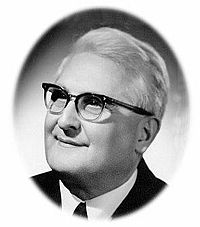László Kalmár Contents Biography Elementary functions Notes References External links Navigation menu"A Visit to Hungarian Mathematics"László KalmárMacTutorcb114731891(data)90/690210795730890000 0000 8185 9044n8580269324584mzk2014816187083358528116894603116894603
1905 births1976 deathsUniversity of Szeged facultyMembers of the Hungarian Academy of SciencesHungarian computer scientistsMathematical logiciansHungarian logiciansHungarian JewsHungarian philosophersJewish philosophers20th-century Hungarian mathematiciansAustro-Hungarian mathematicians
EddeMátraházaHungarianmathematicianUniversity of Szegedmathematical logiccomputer scienceUniversity of BudapestKürschákFejérRózsa PéterWorld War IHaarRieszmathematical logicpredicate calculusdecidablebinary predicaterecursivetermQuineprimitive recursiveelementary recursivecomputer scienceHungarian Academy of Scienceselementary functionsnumber-theoretic functionscompositionregister machineSchwichtenberg

Portrait of László Kalmár
László Kalmár (27 March 1905, Edde – 2 August 1976, Mátraháza) was a Hungarian mathematician and Professor at the University of Szeged. Kalmár is considered the founder of mathematical logic and theoretical computer science in Hungary.
Contents
1 Biography
2 Elementary functions
3 Notes
4 References
5 External links
Biography
Kalmár was of Jewish ancestry.[1] His early life mixed promise and tragedy. His father died when he was young, and his mother died when he was 17, the year he entered the University of Budapest, making him essentially an orphan.
Kalmár's brilliance manifested itself while in Budapest schools. At the University of Budapest, his teachers included Kürschák and Fejér. His fellow students included the future logician Rózsa Péter. Kalmár graduated in 1927. He discovered mathematical logic, his chosen field, while visiting Göttingen in 1929.
Upon completing his doctorate at Budapest, he took up a position at the University of Szeged. That university was mostly made up of staff from the former University of Kolozsvár, a major Hungarian university before World War I that found itself after the War in Romania. Kolozsvár was renamed Cluj. The Hungarian university moved to Szeged in 1920, where there had previously been no university. The appointment of Haar and Riesz turned Szeged into a major research center for mathematics. Kalmár began his career as a research assistant to Haar and Riesz. Kalmár was appointed a full professor at Szeged in 1947. He was the inaugural holder of Szeged's chair for the Foundations of Mathematics and Computer Science. He also founded Szeged's Cybernetic Laboratory and the Research Group for Mathematical Logic and Automata Theory.
In mathematical logic, Kalmár proved that certain classes of formulas of the first order predicate calculus were decidable. In 1936, he proved that the predicate calculus could be formulated using a single binary predicate, if the recursive definition of a term was sufficiently rich. (This result is commonly attributed to a 1954 paper of Quine's.) He discovered an alternative form of primitive recursive arithmetic, known as elementary recursive arithmetic, based on primitive functions that differ from the usual kind. He did his utmost to promote computers and computer science in Hungary. He wrote on theoretical computer science, including programming languages, automatic error correction, non-numerical applications of computers, and the connection between computer science and mathematical logic.
Kalmar is one of the very few logicians who has raised doubts about Church's Thesis that all intuitively mechanistic, algorithmic functions are representable by recursive functions.
[2]
Kalmar was elected to the Hungarian Academy of Sciences in 1949, and was awarded the Kossuth Prize in 1950 and the Hungarian State Prize in 1975.
In 1933 Kalmár married Erzsébet Arvay; they had four children.

The face on the middle medallion is Kalmár's
Elementary functions
Kalmar defined what are known as elementary functions, number-theoretic functions (i.e. those based on the natural numbers) built up from the notions of composition and variables, the constants 0 and 1, repeated addition + of the constants, proper subtraction ∸, bounded summation and bounded product (Kleene 1952:526). Elimination of the bounded product from this list yields the subelementary or lower elementary functions. By use of the abstract computational model called a register machine Schwichtenberg provides a demonstration that "all elementary functions are computable and totally defined" (Schwichtenberg 58).
Notes
^ Reuben Hersh & Vera John-Steiner (1993). "A Visit to Hungarian Mathematics" (PDF). Retrieved 19 October 2012..mw-parser-output cite.citationfont-style:inherit.mw-parser-output .citation qquotes:"""""""'""'".mw-parser-output .citation .cs1-lock-free abackground:url("//upload.wikimedia.org/wikipedia/commons/thumb/6/65/Lock-green.svg/9px-Lock-green.svg.png")no-repeat;background-position:right .1em center.mw-parser-output .citation .cs1-lock-limited a,.mw-parser-output .citation .cs1-lock-registration abackground:url("//upload.wikimedia.org/wikipedia/commons/thumb/d/d6/Lock-gray-alt-2.svg/9px-Lock-gray-alt-2.svg.png")no-repeat;background-position:right .1em center.mw-parser-output .citation .cs1-lock-subscription abackground:url("//upload.wikimedia.org/wikipedia/commons/thumb/a/aa/Lock-red-alt-2.svg/9px-Lock-red-alt-2.svg.png")no-repeat;background-position:right .1em center.mw-parser-output .cs1-subscription,.mw-parser-output .cs1-registrationcolor:#555.mw-parser-output .cs1-subscription span,.mw-parser-output .cs1-registration spanborder-bottom:1px dotted;cursor:help.mw-parser-output .cs1-ws-icon abackground:url("//upload.wikimedia.org/wikipedia/commons/thumb/4/4c/Wikisource-logo.svg/12px-Wikisource-logo.svg.png")no-repeat;background-position:right .1em center.mw-parser-output code.cs1-codecolor:inherit;background:inherit;border:inherit;padding:inherit.mw-parser-output .cs1-hidden-errordisplay:none;font-size:100%.mw-parser-output .cs1-visible-errorfont-size:100%.mw-parser-output .cs1-maintdisplay:none;color:#33aa33;margin-left:0.3em.mw-parser-output .cs1-subscription,.mw-parser-output .cs1-registration,.mw-parser-output .cs1-formatfont-size:95%.mw-parser-output .cs1-kern-left,.mw-parser-output .cs1-kern-wl-leftpadding-left:0.2em.mw-parser-output .cs1-kern-right,.mw-parser-output .cs1-kern-wl-rightpadding-right:0.2em
^ * Kalmar, L. 1959. ‘An Argument Against the Plausibility of Church's Thesis’. In Heyting, A. (ed.) Constructivity in Mathematics. Amsterdam: (1959 North-Holland).
References
Stephen C. Kleene 1952, 1971 6th reprint with emendations, 10th printing 1999, Introduction to Metamathematics, North-Holland Publishing Company, Amsterdam NY.
ISBN 0-7204-2103-9- Helmut Schwichtenberg, see under "Computability" at http://sakharov.net/foundation.html, or http://www.mathematik.uni-muenchen.de/~schwicht/lectures/logic/ws03/comp.pdf . Exact source of this TBD.
External links
| Wikimedia Commons has media related to László Kalmár (mathematician). |
László Kalmár at the Mathematics Genealogy Project
MacTutor The source for most of this entry.
1905 births, 1976 deaths, Hungarian computer scientists, Hungarian Jews, Hungarian logicians, Hungarian philosophers, Jewish philosophers, Mathematical logicians, Members of the Hungarian Academy of Sciences, University of Szeged facultyUncategorized